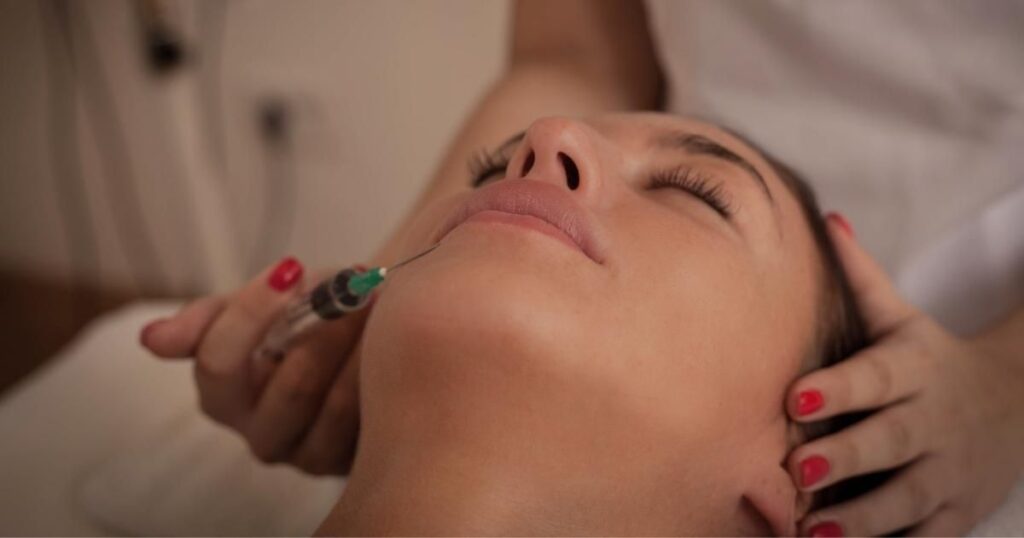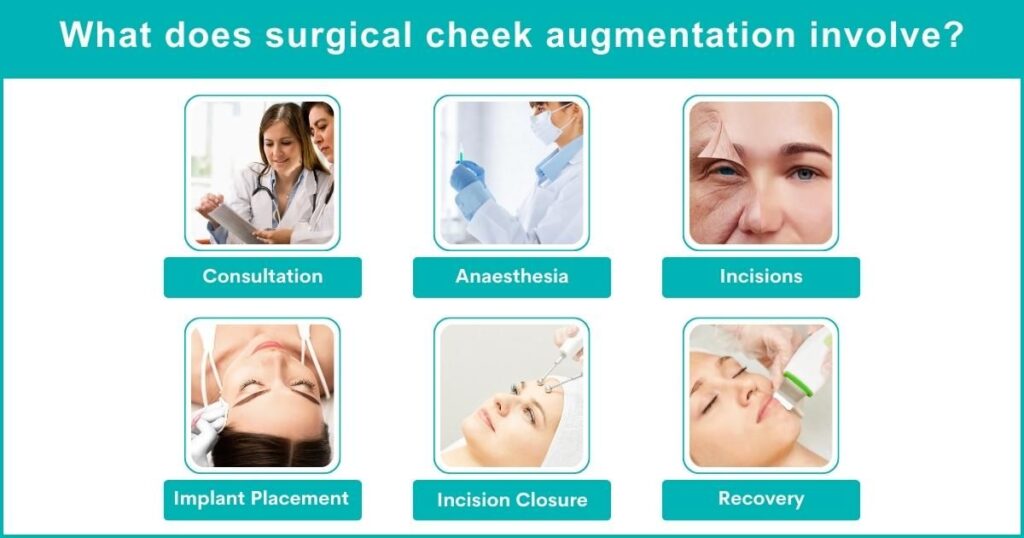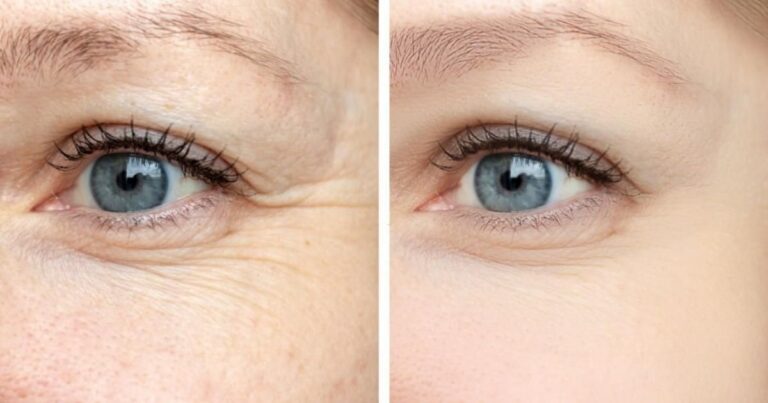Cheek augmentation is a way to enhance cheek volume and shape through surgery. This article discusses the risks and benefits of both procedures, what is involved in surgical cheek augmentation, how fillers and surgery recover, long-term results, and what to consider before deciding which is best for you.
What is Cheek Augmentation?

Cheek augmentation is like adding padding to your cheeks. Some people have cheeks that look flat, and they want them to look fuller. Think of it as stuffing more cushions into a sofa to make it plumper! Doctors do it, and they can use two methods: fillers, which are like gel injections, or surgery, which is a bit more complicated.
What are the Pros and Cons of Cheek Augmentation with Fillers?
Cheek augmentation with fillers has both advantages and disadvantages. Let’s look at the pros and cons:
Pros:
Book A Consultation With Dr Tarek Bayazid
Top-rated Plastic Surgeon For Fillers in Dubai
Installment Plan Available
- Enhanced cheek volume and shape.
- A non-surgical procedure with no incisions.
- A quick and relatively comfortable procedure.
- Immediate results with little to no downtime.
- Reversible, as fillers can be dissolved.
Cons:
- Temporary results, usually lasting 6-12 months.
- Potential for minor swelling or bruising.
- Requires maintenance treatments for sustained results.
- Allergic reactions or complications are possible, although rare.
What Does Surgical Cheek Augmentation Involve?

Surgical cheek augmentation is a procedure to enhance the shape and volume of the cheeks. Here are the measures to take:
- Consultation: A cosmetic surgery specialist will first interview you and determine whether surgery is right for you based on your goals.
- Anaesthesia: Surgery is performed under anaesthesia to ensure you don’t feel pain.
- Incisions: The surgeon will make small incisions to access the cheekbones, usually inside the mouth or along the natural creases of the cheeks.
- Implant Placement: Next, the surgeon will carefully insert implants made of solid materials, like silicone or porous substances, to add volume and enhance the shape of the cheeks. They may secure the implants with sutures or screws.
- Incision Closure: Once the implants are in place, the surgeon will close the incisions using dissolvable or regular stitches that will be removed later.
- Recovery: In the recovery area, you’ll be monitored for a while after surgery. You may experience swelling and discomfort, but these usually subside over time.
How do Fillers and Surgery Compare for Cheek Augmentation?
Here’s a simplified table comparing fillers and surgery for cheek augmentation:
| Aspect | Fillers | Surgery |
| Procedure | Non-surgical | Surgical |
| Anaesthesia | Usually local anaesthesia | General anaesthesia |
| Duration | Quick, usually minutes | Longer, typically hours |
| Results | Temporary, may last 6-18 months | Permanent, long-lasting |
| Downtime | Minimal to none | Moderate to significant |
| Risks and complications | Rare, minor | Possible, including infection, scarring, etc. |
| Customisation | It can be adjusted and modified | Fixed implants cannot be easily changed |
| Cost | Less expensive | More expensive |
What is the Recovery Process Like for Fillers vs Surgery in Cheek Augmentation?
Here’s a simplified table comparing the recovery process for fillers and surgery in cheek augmentation:
| Recovery Process | Fillers | Surgery |
| Recovery Time | Typically minimal to no downtime | Several days to weeks |
| After 24 hours | Avoid touching or applying pressure to the treated area | Follow post-operative care instructions provided by the surgeon |
| After 1 week | Resume normal activities | Begin gentle facial exercises, as advised by the surgeon |
| After 2 weeks | Final results visible | Resume regular exercise routines, avoiding excessive strain on the face |
| After 4-6 weeks | Follow-up appointment if needed | May require additional follow-up appointments to monitor healing |
| Dos and Don’ts | – Avoid extreme temperatures | – Avoid strenuous activities or heavy lifting |
| – Avoid rubbing or massaging the treated area | – Avoid smoking or consuming alcohol, as they can delay healing | |
| – Follow any specific instructions provided by the practitioner | – Take prescribed medications as directed | |
| – Maintain a healthy diet and get sufficient rest for proper healing |
What are the Long-Term Results of Cheek Augmentation with Fillers or Surgery?

Cheek augmentation refers to a procedure that enhances the shape and volume of the cheeks. It can be done using fillers (injections) or through surgery. When it comes to the long-term results of cheek augmentation, here’s what you need to know:
Fillers for Cheek Augmentation:
- Temporary results
- It lasts for several months
- May require touch-ups
- Non-invasive procedure
Surgery for Cheek Augmentation:
- Permanent results
- It lasts for many years
- One-time procedure
- Involves incisions and recovery time
How Do I Select the Right Procedure: Fillers or Surgery for Cheek Augmentation?
Here are some factors to consider when deciding:
- Your budget: Fillers are generally more affordable than surgery.
- Your desired results: Surgery may be a better option if you want more permanent results.
- Your lifestyle: If you are busy, fillers may be a better option because you can resume your normal activities more quickly after the procedure.
- Your health: If you have health conditions, talk to your doctor about whether fillers or surgery are safe.
What Expert Advice is Available for Consultation Tips in Cheek Augmentation?
Here is some expert advice for consultation tips in cheek augmentation:
- Do your research. Learning about cheek augmentation is essential before you even consider meeting with a plastic surgeon. It includes understanding the different procedures available, the risks and benefits of each, and the costs involved.
- Be clear about your goals. When you meet with a plastic surgeon, be clear about your goals for cheek augmentation. How do you hope the procedure will help you? Do you want to add volume to your cheeks, improve facial contours, or both?
- Ask questions. Be bold and ask questions during your consultation. Here you can get all your questions answered to make an informed decision about cheek augmentation.
- Find a qualified surgeon. Finding a qualified plastic surgeon with experience performing cheek augmentation is essential. Find a qualified plastic surgeon by consulting your family doctor for referrals or the American Society of Plastic Surgeons
- Trust your gut. Feel free to walk away if you are uncomfortable with a particular surgeon or have doubts about the procedure. Plenty are available if you are seeking other qualified surgeons who can help you.
- Bring photos. Bring photos of yourself that show your current facial appearance. It will help the surgeon to understand your goals and create an appropriate treatment plan.
- Be prepared to discuss your medical history. Including any allergies or health conditions that you have, the surgeon must know your medical history. It will help them to determine if cheek augmentation is safe for you.
- Bring along a friend or relative. Your friend or family member can be helpful when you attend your consultation. They can offer support and help you remember everything the surgeon says.
Cheek augmentation offers options for enhancing cheek volume and shape. Fillers provide temporary results and are non-invasive, while surgery offers permanent results but involves a more extended recovery period. Consider your budget, desired results, lifestyle, and health when deciding between fillers and surgery. Choosing the right procedure requires consulting with a qualified plastic surgeon.
If you are considering cheeks fillers, then visit Dr Tarek’s clinic. With Dr Tarek, you’re getting a board-certified plastic surgeon, and a trusted advisor committed to helping you reach your aesthetic aspirations. He combines innovative techniques with a tailored approach to deliver natural-looking results that are unique to you.
Ready to sculpt your cheeks to perfection? Book a consultation with Dr Tarek today. Explore your options for cheek augmentation and make an informed decision for your aesthetic journey.








